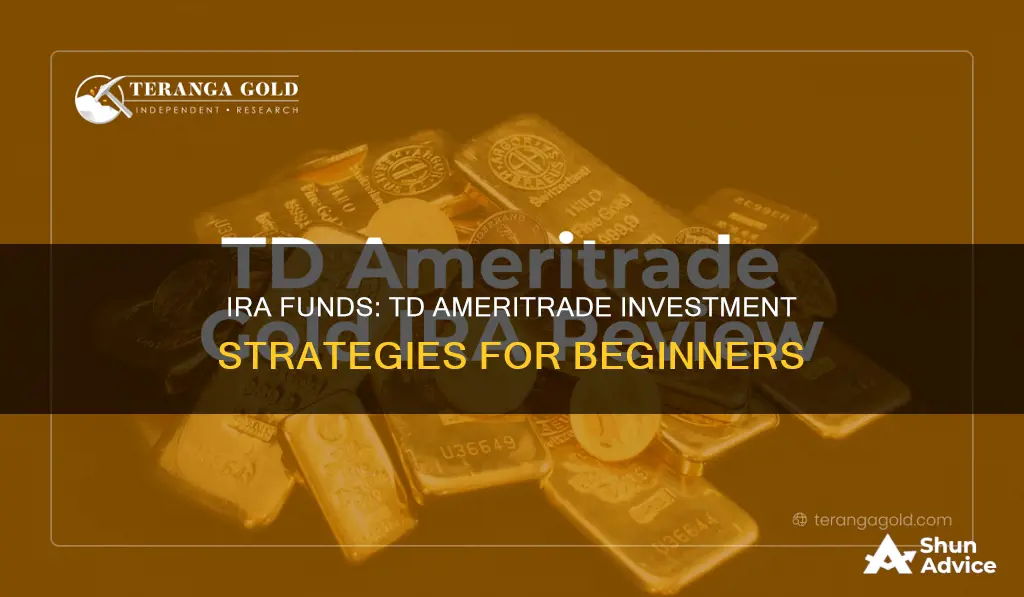
TD Ameritrade, now acquired by Charles Schwab, offers a range of investment options for retirement planning, including Individual Retirement Accounts (IRAs). IRAs are personal retirement savings accounts that offer tax benefits and a range of investment options. TD Ameritrade provides access to thousands of mutual funds and exchange-traded funds (ETFs) to build a portfolio. It also offers commission-free ETF trading, no-transaction-fee mutual funds, and investment guidance from professional advisors. When deciding between a Traditional IRA and a Roth IRA, investors should consider their tax bracket, time until retirement, and withdrawal timing. A Traditional IRA may be suitable for those with tax-deductible contributions and a higher tax bracket today than during retirement. In contrast, a Roth IRA offers tax-free withdrawals and is suitable for those with after-tax contributions.
What You'll Learn

TD Ameritrade IRA account types and features
TD Ameritrade, now acquired by Charles Schwab, offers IRA accounts to help you meet your retirement goals. TD Ameritrade IRA accounts come with advantages and features that make investing for your future easier. There are no maintenance fees or account minimums, although service fees and exception fees may still apply.
TD Ameritrade offers a wide range of investment choices, online tools and calculators, investment seminars, third-party research, portfolio guidance, and other resources that are not typically found in an employer-sponsored 401k plan.
When deciding between a Traditional IRA and a Roth IRA, you should consider your tax bracket, how many years you have until retirement, and when you wish to begin making withdrawals. A Traditional IRA may be a smart choice if your contributions are tax-deductible and you are in a higher tax bracket today than you will be during retirement. On the other hand, a Roth IRA will result in more after-tax income during retirement because qualified withdrawals are tax-free.
TD Ameritrade also offers the option of converting your Traditional IRA to a Roth IRA. This can be advantageous for individuals with large Traditional IRA accounts who expect their future tax bills to remain the same or grow by the time they start withdrawing funds. However, remember that conversions trigger a tax bill, so it may be more attractive to convert the further you are from retirement, giving your earnings more time to grow and compensate for the tax bill.
In addition to Traditional and Roth IRAs, TD Ameritrade also provides the option of a Rollover IRA. If you are interested in this option, you can select "Rollover" on your TD Ameritrade account application and contact the plan administrator of your old retirement plan to complete the necessary paperwork.
TD Ameritrade offers various tools to help you select your retirement account investments, including the Retirement Calculator and the IRA Selection Tool. It is important to periodically check both the contribution rules and the income rules to ensure your eligibility to participate and contribute.
Hedge Fund Investment: Choosing the Right One
You may want to see also

Differences between Traditional and Roth IRA
When it comes to investing in your future, it's important to understand the differences between a Traditional IRA and a Roth IRA. Both types of accounts offer tax advantages for retirement savings, but they work in different ways. Here are the key differences between Traditional and Roth IRAs:
Tax Treatment of Contributions
- Traditional IRA: Contributions are often made with pre-tax dollars, meaning you may be able to deduct the amount you contribute from your taxable income for that year. This can provide immediate tax relief. However, your contributions and earnings will be taxed when you withdraw the money in retirement.
- Roth IRA: Contributions are made with after-tax dollars, meaning you don't get an upfront tax break. However, the money grows tax-free, and qualified distributions, including earnings, can be withdrawn tax-free in retirement.
Tax Treatment of Distributions
- Traditional IRA: When you withdraw money from a Traditional IRA during retirement, it is taxed as ordinary income. If you withdraw before reaching the age of 59 and a half, you may also have to pay a 10% early withdrawal penalty, unless an exception applies. Additionally, you are generally required to start taking minimum distributions at age 73.
- Roth IRA: With a Roth IRA, you can withdraw your contributions at any time, for any reason, without taxes or penalties. As long as you meet certain requirements, such as having held the account for at least five years and being over the age of 59 and a half, you can also withdraw your earnings tax-free. There are no required minimum distributions during your lifetime.
Income and Eligibility
- Traditional IRA: Generally, anyone with earned income can contribute to a Traditional IRA. However, the tax-deductibility of contributions may be reduced or eliminated at higher income levels, especially if you or your spouse has access to a workplace retirement plan.
- Roth IRA: There are income limits for contributing to a Roth IRA. In 2024, single filers must have a modified adjusted gross income (MAGI) of less than $146,000, and married couples filing jointly must have a MAGI of less than $230,000. Additionally, Roth IRAs have income caps beyond which individuals cannot contribute at all.
Age Limits
- Traditional IRA: Since 2020, there are no age limits for contributing to a Traditional IRA, thanks to changes made by the SECURE Act.
- Roth IRA: You can contribute to a Roth IRA at any age, as long as you have earned income within the IRS income limits.
When deciding between a Traditional and Roth IRA, it's important to consider your current tax bracket, your expected tax bracket in retirement, your income, your age, and your retirement goals. Both types of accounts have their own advantages, and it's up to you to choose the one that best suits your financial situation and needs.
HOA Reserve Funds: CD Investment Strategies for Your Community
You may want to see also

How to set up a TD Ameritrade IRA account
Setting up a TD Ameritrade IRA account can be a great way to start investing for your retirement. TD Ameritrade, now acquired by Charles Schwab, offers a range of retirement account types, including Traditional IRAs and Roth IRAs, to help you meet your goals based on your lifestyle and income. Here's a step-by-step guide on how to set up a TD Ameritrade IRA account:
- Visit the TD Ameritrade website or a local branch to get started. You can also call their customer support for assistance.
- Determine the type of IRA account you want to open. The two main options are Traditional IRA and Roth IRA. Consider factors such as your tax bracket, time until retirement, and withdrawal plans when deciding between the two.
- Check the age requirements for your state. Most states require you to be at least 18 years old, but a few states have a minimum age of 19.
- If you're rolling over funds from an existing retirement plan, select "Rollover" on your TD Ameritrade account application. You will also need to contact your previous plan administrator and complete the necessary paperwork.
- Complete the account application process, providing any required personal and financial information.
- Familiarize yourself with the rules for IRA contributions and income limits, as they may vary from year to year. Ensure you periodically check your eligibility to participate and contribute.
- Once your account is set up, choose your investments wisely. TD Ameritrade offers tools like the Retirement Calculator and the IRA Selection Tool to help you select the right investment options.
- Fund your account by making a deposit or setting up automatic contributions through the TD Ameritrade Mobile App or other available methods.
Remember, a TD Ameritrade IRA account offers advantages like no maintenance fees or account minimums, a wide range of investment choices, and helpful resources to build a retirement portfolio tailored to your needs.
Who Should Invest in Mutual Funds?
You may want to see also

Investment options for a TD Ameritrade IRA
TD Ameritrade, now acquired by Charles Schwab, offers a wide range of investment options for your Individual Retirement Account (IRA). IRAs are personal retirement savings accounts that offer tax benefits and a range of investment options.
When it comes to choosing between a Traditional IRA and a Roth IRA, there are several factors to consider, including your tax bracket, the number of years until your retirement, and when you plan to start making withdrawals. A Traditional IRA may be a good option if your contributions are tax-deductible and you are in a higher tax bracket today than you will be during retirement. On the other hand, a Roth IRA offers tax-free withdrawals of qualified distributions, making it a good choice if you expect your future tax bills to stay at the same level or grow when you start withdrawing funds. It's important to note that conversions from a Traditional IRA to a Roth IRA trigger a tax bill, so it may be more advantageous to convert the further you are from retirement, giving your earnings more time to grow.
With a TD Ameritrade IRA, you can choose from various investment options to build a portfolio that aligns with your unique goals and risk tolerance. The company offers thousands of mutual funds and exchange-traded funds (ETFs) to choose from. Additionally, TD Ameritrade provides access to investment guidance from professional advisors through Schwab, their affiliate company. They also offer robo-advisory services and the ability to trade stocks, ETFs, and options on their online platform without commission fees.
When building your retirement portfolio, it's generally recommended to start with a broad stock fund and a broad bond fund as a foundation. You can then consider adding more complex investments on top of this foundation. Vanguard Total Stock Market ETF (VTI) and BNY Mellon Core Bond ETF (BKAG) are two options that can serve as good starting points for your TD Ameritrade IRA.
VTI is one of the cheapest broad stock funds on the TD Ameritrade platform, providing diversified exposure to the US equity market. It aims to track the performance of the CRSP US Total Market Index, which includes thousands of stocks across the market capitalization spectrum.
BKAG, on the other hand, is a passively managed ETF that tracks the performance of the Bloomberg Barclays US Aggregate Total Return Index. It provides investors with broad exposure to the overall US bond market. With an expense ratio of 0%, it is among the cheapest broad-based bond funds offered by TD Ameritrade.
Remember to consider your financial goals, risk tolerance, and time horizon when selecting investments for your TD Ameritrade IRA.
Strategies for Investing in JP Morgan's Hedge Fund
You may want to see also

Distributing your TD Ameritrade IRA funds
TD Ameritrade offers several methods for distributing your IRA funds. You can set up automatic distributions, transfer funds to another account, or transfer holdings.
All funds coming into an IRA are reported to the IRS and also mailed to clients on Form 5498. Form 5498 covers the period between January 1, 2023, and December 31, 2023. Traditional IRA and Roth IRA contributions made by April 15, 2024, for the 2023 tax year will also be included. Forms are mailed by May 31, 2024, for the 2023 tax year.
If you remove funds from your account during the calendar year, you will receive a 1099-R form showing the amounts reported to the IRS. These forms are mailed by January 31 for the preceding calendar year.
Direct Transfers are not reported to the IRS and will not show on either of these forms.
If you have any additional questions on how your IRA transactions are reported, please consult your tax advisor or visit the IRS website.
The value of your conversion to a Roth IRA will be reported on Form 1099-R from your Traditional IRA. It will also be reported as a conversion amount on Form 5498 from your Roth IRA. For more information on these forms, consult your tax advisor or visit the IRS website.
Invest in HDFC Mutual Fund: Secure Your Future
You may want to see also
Frequently asked questions
A TD Ameritrade IRA account has no maintenance fees or account minimums, and offers access to investment guidance from professional advisors through Schwab.
The main difference is that a Roth IRA is funded with after-tax dollars, meaning contributions are not tax-deductible, but withdrawals are tax-free. With a Traditional IRA, contributions may be tax-deductible, but withdrawals are taxed as income.
You can set up an account by visiting the TD Ameritrade website or app, or by calling their customer service line at 800-454-9272.
TD Ameritrade offers many tools to help you select your retirement account investments, including the Retirement Calculator and the IRA Selection Tool.







